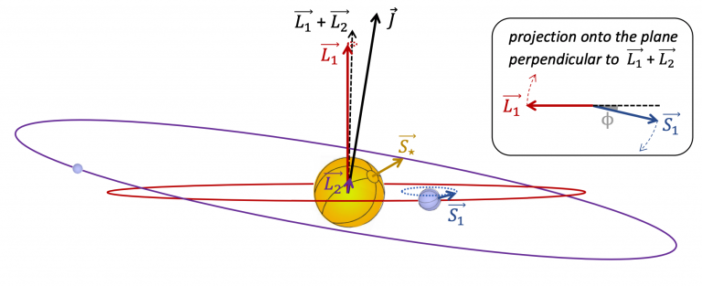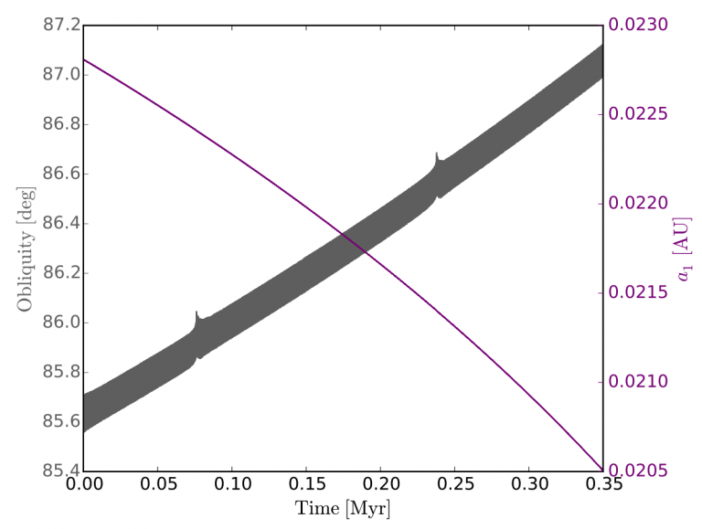Editor’s note: Astrobites is a graduate-student-run organization that digests astrophysical literature for undergraduate students. As part of the partnership between the AAS and astrobites, we occasionally repost astrobites content here at AAS Nova. We hope you enjoy this post from astrobites; the original can be viewed at astrobites.org.
Title: Obliquity Tides May Drive WASP-12b’s Rapid Orbital Decay
Author: Sarah Millholland, Gregory Laughlin
First Author’s Institution: Yale University
Status: Published in ApJ
It’s not an easy life being a hot Jupiter. Besides their eternal loss of privacy due to being on the hit list of astronomers since the very moment they are detected, theirs is a tale of intense drama. The extreme radiation and tidal flexing they experience due to their proximity to their host stars make them ideal targets for studying planetary science in extreme physical conditions, particularly since there are no hot-Jupiter analogs in our solar system. One of these weirdos, and also one of the most studied hot Jupiters in recent years, is WASP-12b. In addition to being one of the hottest hot Jupiters around (with equilibrium temperature of ~2500 K) and losing mass at an exceptionally high rate, it is also the only known hot Jupiter inspiralling so rapidly towards its star that we can observe this decay in real time. It has been speculated that sustained tidal interactions between the star and the planet could be responsible for the observed orbital decay of the planet. The authors of today’s paper investigate the case of WASP-12b in this context to understand what might be driving its orbital decay.
Turning with the Tide
Tidal interactions between a star and its planet act together to dissipate the orbital energy of the system in the interiors of the planet and the star. Think of the planet and the star acting like resistors that dissipate the gravitational energy of their orbits into heat due to tidal flexing in their interiors. This tidal dissipation is most effective when a planet has large orbital eccentricity and obliquity (the angle between the orbital plane and spin axes of the planet). However, for a lonely hot Jupiter with no other planetary companion in the system, tidal torques from the host star over time would eventually force the planet to reach an equilibrium state with low orbital eccentricity and obliquity, which would reduce the tidal dissipation the planet experiences. The fact that WASP-12b’s orbit is decaying rapidly indicates that there may be some other force at work helping to drive its sudden inspiral. The authors of today’s paper propose that the presence of another planet in the system (see Figure 1) could sustain WASP-12b’s obliquity, causing the planet to continue to experience high tidal dissipation and preventing its inspiral from stabilizing.

Figure 1: Schematic of the spin-orbit interactions between WASP-12b and another planet in the system. In the case of spin-orbit resonance (called a Cassini state), the spin angular momentum vector S1 and orbital angular momentum vector L1 precess about a common axis at the same rate. [Millholland & Laughlin 2018]
The authors simulate the evolution of the WASP-12 system using an obliquity tide model that couples two things: the relations governing the secular dynamical interactions between WASP-12b and another planet, and the tidal interaction between the star and WASP-12b. These interactions then combine to cause the inspiral. With very little fine-tuning of the properties of the perturbing planet and the efficiency of tidal dissipation (which is dependent on the unknown interior structure of WASP-12b), they are able to reproduce the inspiral rate that we have observed for the system (Figure 2). An interesting result of their analyses using the obliquity tide model is that even if WASP-12b starts with a very low obliquity (< 1°), it can easily get locked into a Cassini state and attain a high obliquity within the lifetime of the planetary system.

Figure 2: Simulated evolution of WASP-12b’s obliquity (gray) and semi-major axis (purple) with respect to time from the obliquity tide model. Note that tidal dissipation due to obliquity tides is a runaway process: orbital decay (represented by the decreasing semi-major axis) due to tidal dissipation leads to increasing obliquity as the other planet forces WASP-12b to maintain the spin-orbit resonance. This further increases the efficiency of tidal dissipation. [Millholland & Laughlin 2018]
About the author, Vatsal Panwar:
I am a PhD student at the Anton Pannekoek Institute for Astronomy, University of Amsterdam. I work on characterization of exoplanet atmospheres to understand the diversity and origins of planetary systems. I also enjoy yoga, Lindyhop, and pushing my culinary boundaries every weekend.

